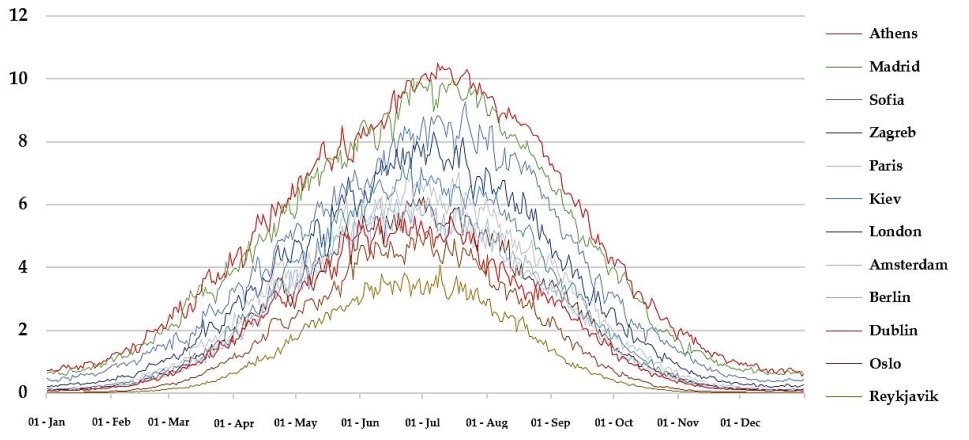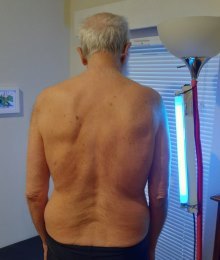Vitamin D winter lasts from 4 to 215 days in Europe
Comprehensive Analysis of Seasonal and Geographical Variation in UVB Radiation Relevant for Vitamin D Production in Europe
Nutrients 2022, 14(23), 5189; https://doi.org/10.3390/nu14235189
Tarinee Khanna 1,†, Rasha Shraim 1,2,† , Masa Zarkovic 1,3, Michiel van Weele 4 , Jos van Geffen 4 and Lina Zgag
Days lacking UVB to make Vitamin D (winter): 4 to 215 days in Europe

5X difference in peak UVB

Dermal synthesis, following sun exposure, is the main source of vitamin D. This study characterizes ambient UVB radiation relevant for vitamin D production in Europe. A biological weighing function was applied to data from the Tropospheric Emissions Monitoring Internet Service (TEMIS) for 46 capital cities over an 18-year period (2004–2021) to isolate wavelengths relevant for vitamin D production (D-UVB). Cumulative and weighted D-UVB (CW-D-UVB) were calculated to approximate seasonal vitamin D accumulation and diminution. Monthly 25(OH)D concentration measurements were extracted from published reports. All data were analyzed by location and time.
Despite a moderate latitudinal range (35–64° N), we observed large—up to five-fold —regional differences: the highest mean diurnal D-UVB dose of 5.57 kJ/m2 (SD = 3.55 kJ/m2) was observed in Nicosia (Cyprus) and the lowest in Reykjavik (Iceland, 1.16 ± 1.29 kJ/m2).
Seasonal differences in diurnal D-UVB dose were even more pronounced, with a median 36-fold difference between annual peak and trough depending on a location (range: 10- to 525-fold).
The mean duration of “vitamin D winter” was 126 days but varied widely (4 to 215 days).
Monthly CW-D-UVB and 25(OH)D changes were very strongly correlated: the changes in 25(OH)D concentration increased by 12.6 nmol/L for every 100 kJ/m2 increment of CW-D-UVB in population-based studies (r2 = 0.79, p-value = 1.16 × 10−37). Understanding the differences in D-UVB radiation can help understand determinants of vitamin D status and guide region- and season-specific safe and effective sunlight exposure recommendations and vitamin D supplementation guidelines.
📄 Download the PDF from Vitamin D Life
4 possible reasons for HIGHER Vitamin D in Northern latitudes
Vitamin D fortification of food - especially Finland
More fish consumption (provided not farmed fish)
- Iceland: fish 91 kg /person annually/ Mainly cod and haddock - which are not farmed
Paler skin
Lactase persistence Jan 2020 FREE PDF
- "" It was found that individuals with the genetic LP variant had considerably higher levels of serum 25(OH)D (P < 2 × 10−16"
2 possible reasons for LOWER vitamin D in Northern Latitudes
Fewer hours of summer UVB
- might get UVB from 9 AM to 3 PM near the eqator, vs. 10 AM to 2 PM in mid-latitudes or 11 AM to 1 PM in high latitudes
- Less intense UVB
Vitamin D Life - UV and D contains
{include}
Vitamin D Life - studies in both categories UV and Europe
This list is automatically updated
{category}
UVB lamp appears to give 2,000 IU/ min. if young, 200 IU/min if senior (founder of Vitamin D Life)
Make your own UVB Vitamin D lamp for 40 dollars - Jan 2019
I turn around while in front of it for 3 minutes every day in the winter and have 10 seconds on my face ~ 600 IU
I found that staying still would cause a "sun" burn in <1 minute
I also take 100,000 IU of vitamin D once every 4 days during all seasons
Have eyes closed while the lamp is on - the UVB will damage the eyes

